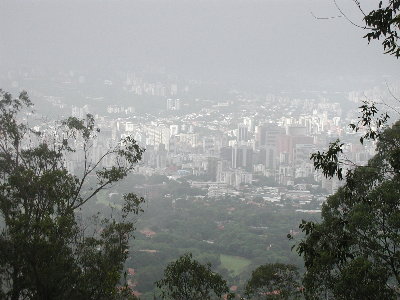2.
Coastal Cordillera: El Avila
(see also: 1.
Birding Caracas)
El Avila is often the first landmark to be noted by the visitor
to Venezuela: it dominates the landward view from Simón
Bolívar International airport and through it one must
travel to reach Caracas. Looming up from the northern limits
of the city, it provides a convenient reference to help the
visitor orient her or himself in the capital.
Abutting the northern edge of the city and a 40 minute walk
from downtown Caracas, El Avila is Venezuela’s most
accessible national park and, although it is well known to
local hikers and fitness enthusiasts, it has been long neglected
by visiting birders. Early portraits of the Avila, including
sketches by Alexander von Humboldt, depict a largely deforested
mountain with grasslands occupying most of the southern slopes
and a narrow band of cloud forest at the top. Indeed, the
Avila has been cultivated for many centuries and the remnants
of old coffee plantations, Spanish mule trails and colonial
dwellings abound. The forest cover has been regenerating since
the last century, a trend reinforced by the creation of the
85,192 ha El Avila National Park in 1958.
With elevations ranging from 120 to 2765 m, the Avila contains
a range of habitats. On the coast, xeric coastal scrub gives
way to forests which are semi-deciduous at the lower elevations,
but become increasingly humid toward the ridge tops. Cloud
forest prevails above 1600 m up until the appearance of sub-páramo
vegetation above 2200 m on the mountain tops. The southern
(city) side is notably drier, with semi-deciduous forests
from the city limits up to about 1700 m, and above that a
humid forest and then cloud forest.
The birds are typical of the Coastal Cordillera and consist
of Andean species mixed with local endemics. Xeric scrub communities
with several endemics are found along the coast, whilst tanager
flocks are common in the more humid forests and many Andean
species can be found in the sub-páramos. The Avila
provides an excellent location to search for several Venezuelan
endemics and specialities such as Blood-eared Parakeet, Green-tailed
Emerald, Buffy Hummingbird, Rufous-shafted Woodstar, White-tipped
Quetzal, Black-throated Spinetail, Caracas Tapaculo, Scalloped
Antthrush, Handsome Fruiteater, Venezuelan Tyrannulet and
Ochre-breasted Brush-Finch. The best birding spots are the
Galipán – Hotel Humboldt ridge top for cloud
forest specialities, Los Venados for hummingbirds (including
Green-tailed Emerald, Rufous-shafted Woodstar and Spangled
Coquette) and semi-deciduous forest species and Sabas Nieves
and the Cortafuegos for more open scrub birding.

Photo: Caracas from the Sabas Nieves Trail (Chris Sharpe)
A variety of excellent hotels to suit all birders tastes
are to be found in Caracas.
Specialities and endemics
Rufous-vented Chachalaca S
Band-tailed Guan S
Helmeted Curassow S
Venezuelan Wood-Quail E
Venezuelan Parakeet E
Blood-eared Parakeet E
Maroon-faced Parakeet S
Lilac-tailed Parrotlet S
Pale-bellied Hermit S
Green-tailed Emerald E
Buffy Hummingbird S
Copper-rumped Hummingbird S
Rufous-shafted Woodstar S
White-tipped Quetzal S
Russet-throated Puffbird S
Moustached Puffbird S
Groove-billed Toucanet S
Scaled Piculet S
|
Black-throated Spinetail E
Crested Spinetail S
Guttulated Foliage-gleaner E
Scalloped Antthrush S
Plain-backed Antpitta S
Rusty-breasted Antpitta S
Caracas Tapaculo E
Golden-breasted Fruiteater S
Handsome Fruiteater E
Rufous-lored Tyrannulet S
Venezuelan Tyrannulet S
Stripe-backed Wren S
Black-hooded Thrush S
Trinidad Euphonia S
Glaucous Tanager S
Fulvous-headed Tanager S
Black-faced Grassquit S
Ochre-breasted Brush-Finch S
|
Full bird checklist
Sharpe, C.J. in prep. Lista de las Aves del Parque Nacional
El Avila, Venezuela. Sociedad Conservacionista Audubon de
Venezuela, Caracas, Venezuela. 350 spp. confirmed so far.
The Audubon Society seeks funding to publish this
list – any offers are very welcome! Email Chris
Sharpe.
Links
Bioparques: http://www.parkswatch.org/parkprofiles/avila/Avila_spanish.shtml
http://www.venezuelaturistica.com/IAvila.htm
(see also: 1. Birding
Caracas)
|